
 |
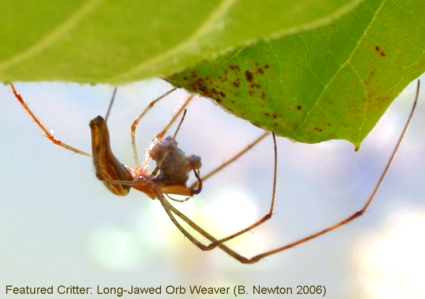 |
The
Hemlock Woolly Adelgid Project University
of Kentucky College of Agriculture |
| The Hemlock Woolly Adelgid Project | ||
|
Why
is HWA a problem? What
can teachers and students do to help? Currently, the University of Kentucky is gathering information about the location of hemlock trees in Kentucky. Teachers and students can help us by sending us the approximate location (or GPS coordinates) of hemlock trees. The Departments of Forestry and Entomology can then plot those locations into digital maps to help monitor the spread of HWA. If you live in extreme southeastern Kentucky, you can also search hemlock trees for signs of HWA infestation. Get
started! More information: UK Entomology
Factsheet: Meeting the Threat of the Hemlock Woolly Adelgid USDA Guidelines for HWA: PDF article Life Stages of HWA: PDF factsheet University of Kentucky Hemlock and HWA Survey Form: PDF data sheet |
||
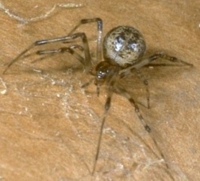 American House Spider (R. Bessin 2000) |
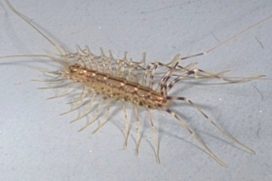 House Centipede (R. Bessin 2000) |
||
Decaying
Logs Look for decaying logs in piles of firewood or forests. Tree-lined streams and other small stands of trees may also have large logs. The best logs for winter arthropod viewing will be large and soft. |
|||
 Flat Bark Beetle Larva (B. Newton 2003) |
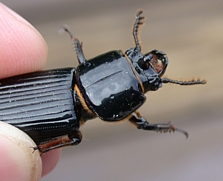 Bess Beetle (B. Newton 2004) |
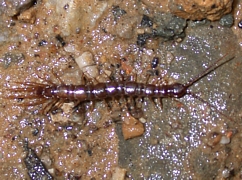 Centipede (B. Newton 2006) |
|
| Aquatic
Habitats |
|||
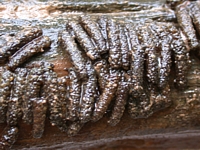 Cases of Caddisfly Larvae (B. Newton 2002) |
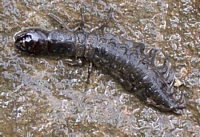 Dobsonfly Larva (B. Newton 2005) |
 Crane Fly Larva (B. Newton 2005) |
|
 Water Beetle (B. Newton 2005) |
 Mayfly Naiad (B. Newton 2005) |
 Stonefly Naiad (B. Newton 2004) |
|
| Featured Critter: Long-Jawed Orb Weavers | ||
The largest species of long-jawed orb-weavers have a body length of about 1" with a leg-span of 2". They are common in sycamore branches that overhang lakes and streams in Kentucky. Other species are common in meadows, gardens, row-crops, and along the forest-edge. Also belonging to the family Tetragnathidae are the "orchard spiders." Although closely related, orchard spiders do not look very much like long-jawed orb weavers. For more information about long-jawed orb weavers and orchard spiders, visit the Long-Jawed Orb Weaver Critter File. |
||
| Entomology Media | ||
by Matthew Reinhart There are thousands of children's books out there, and many of them are about insects. The writer of children's entomology literature faces a difficult task: create a book that stands out. The Insect-Lo-Pedia, part of Matthew Reinhart's "Young Naturalists Handbook" series, scores in the content department. It has lots of interesting facts and figures about insects and covers all the basics, like "insect anatomy" and "what is and what is not an insect." This is the stuff that is interesting and educational for 7-9 year-olds. Lots of books have this kind of entomological information, but many writers of entomology books for children place the information randomly throughout the book, or organize the info by topic. Instead, Reinhart's book appeals because he breaks the info down by "type of insect." In fact, without spelling it out, he covers every major scientific insect order (26 of them), with pictures and facts for each order. So, along with the usual insects like beetles and butterflies, Reinhart includes seldom-encountered insect orders (like rock crawlers and web spinners) and common insect orders that are rarely mentioned in kid's literature (like scorpionflies and thrips). This thorough coverage lives up to the title "Insect-Lo-Pedia." One thing that I don't understand: why does Reinhart include lots of detailed scientific species names (Phryganea grandis and Megaloprepus coerulatus, e.g.), but leave out the scientific insect order names? I would like to have seen the scientific order names instead of species names, especially since the book is organized by insect order. My only other complaint about Insect-Lo-Pedia is with the style of the artwork. The insect drawings are colorful and anatomically accurate, but generic, and maybe a little "cute" for the 7-9 set. I would expect that a 7-9 year-old who wants this level of insect information might prefer either photos or highly realistic drawings. But that's just my taste: Reinhart sells a lot of books, and so do other children's writers who use this art style. Tom
Myers, Nature Photographer |
||
|
||
| Upcoming Events | |||||||||||||||||
|
|||||||||||||||||
|
|||||||||||||||||
| Wee Beasties Mailing List | ||
If you would like to know when each new Wee Beasties issue is posted online, send us your email address to blaken@uky.edu and we will put you on the list! Also visit our Youth Entomology Web Resources for lesson plans and more. |
||
|
||
| Contact | |||
If you have ideas, experiences, or information that you would like to share or would like information about educational resources available through the University of Kentucky, Department of Entomology, write, phone, or email: Blake Newton
Educational
Programs of the Cooperative Extension Service serve all people regardless
of race, color, age, sex, religion, disability, or national origin.
|
|||
|
|||